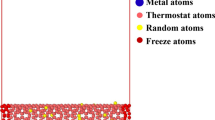Abstract
Mechanism of carbon nanotube bonding onto the metal substrate is investigated using molecular dynamics in this study. Different temperatures and types of the metal atoms to the carbon nanotube surface are considered. It is shown that there is close relationship between surface melting and contact length of the bonding. The melting firstly occurs on the surface of the metal and the contact length increases with the melting propagating from the open surface to the interior of the metal as the temperature rising. In addition, the wetting property of the metal atoms plays an important role during the bonding of the carbon nanotube onto the metal. The carbon nanotube will be easily welded onto the metal with excellent wetting property. The results indicate that the bonding process of the carbon nanotube onto the metal can be controlled by two ways. First, concentrating energy on the metal surface to enhance the surface melting. Second, selecting the metal with excellent wetting property or effective method is utilized to enhance the wetting property of the metal atoms to the carbon nanotube surface.





Similar content being viewed by others
References
Andriotis A, Menon M, Gibson H (2008) Realistic nanotube-metal contact configuration for molecular electronics applications. IEEE Sens J 8:910
Arcidiacono S, Walther JH, Poulikakos D, Passerone D, Koumoutsakos P (2005) Solidification of gold nanoparticles in carbon nanotubes. Phys Rev Lett 94:105502
Banerjee S, Puri IK (2008) Enhancement in hydrogen storage in carbon nanotubes under modified conditions. Nanotechnology 19:155702
Banerjee S, Naha S, Puri IK (2008) Molecular simulation of the carbon nanotube growth mode during catalytic synthesis. Appl Phys Lett 92:233121
Baughman RH, Zakhidov AA, de Heer WA (2002) Carbon nanotubes–the route toward applications. Science 297:787
Cha JJ, Weyland M, Briere JF, Daykov IP, Arias TA, Muller DA (2007) Three-dimensional imaging of carbon nanotubes deformed by metal islands. Nano Lett 7:3770
Chen Z, Appenzeller J, Knoch J, Lin YM, Avouris P (2005) The role of metal-nanotube contact in the performance of carbon nanotube field-effect transistors. Nano Lett 5:1497
Chen CX et al (2007) A method for creating reliable and low-resistance contacts between carbon nanotubes and microelectrodes. Carbon 45:436
Daw Baskes (1983) Semiempirical, quantum mechanical calculation of hydrogen embrittlement in metals. Phys Rev Lett 50:1285
Dong L, Youkey S, Bush J, Jiao J, Dubin VM, Chebiam RV (2007) Effects of local Joule heating on the reduction of contact resistance between carbon nanotubes and metal electrodes. J Appl Phys 101:024320
Heinze S, Tersoff J, Martel R, Derycke V, Appenzeller J, Avouris P (2002) Carbon nanotubes as Schottky barrier transistors. Phys Rev Lett 89:106801
Hoover WG (1985) Canonical dynamics: equilibrium phase-space distributions. Phys Rev A 31:1695
Hoover WG (1986) Constant-pressure equations of motion. Phys Rev A 34:2499
Jiang H, Zhu L, Moon K, Wong CP (2007) Low temperature carbon nanotube film transfer via conductive polymer composites. Nanotechnology 18:125203
Mann D, Javey A, Kong J, Wang Q, Dai H (2003) Ballistic transport in metallic nanotubes with reliable Pd ohmic contacts. Nano Lett 3:1541
Plimpton SJ (1995) Fast parallel algorithms for short-range molecular dynamics. J Comp Phys 117:1
Tans SJ, Verschueren ARM, Dekker C (1998) Room-temperature transistor based on a single carbon nanotube. Nature 393:49
Voronov RS, Papavassiliou DV, Lee LL (2006) Boundary slip and wetting properties of interfaces: correlation of the contact angle with the slip length. J Chem Phys 124:204701
Woo Y, Duesberg GS, Roth S (2007) Reduced contact resistance between an individual single-walled carbon nanotube and a metal electrode by a local point annealing. Nanotechnology 18:095203
Yang J, Hu W, Xiao S (2007) Surface melting of close-packed Mg(0001). Solid State Commun 143:545
Zhang Y, Franklin NW, Chen RJ, Dai H (2000) Metal coating on suspended carbon nanotubes and its implication to metal-tube interaction. Chem Phys Lett 331:35
Acknowledgments
This work is supported by National Natural Science Foundation of China (Grant No. 61106111).
Author information
Authors and Affiliations
Corresponding author
Rights and permissions
About this article
Cite this article
Song, X., Zhao, H. Computational study on bonding of carbon nanotubes onto metallic substrates. Microsyst Technol 20, 397–402 (2014). https://doi.org/10.1007/s00542-013-1917-6
Received:
Accepted:
Published:
Issue Date:
DOI: https://doi.org/10.1007/s00542-013-1917-6




